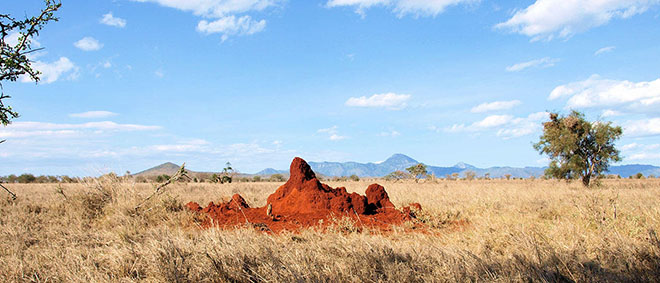When termites cultivate fungi, the queen gets the best bits

Architecture, recycling and fungus cultivation are not inventions exclusive to humans! Termites living in Africa and South Asia have been advancing those innovations successfully for more than 30 million years.
Termites are able to efficiently utilise their plant-based nutrition and maintain multimillion-strong colonies even in harsh semi-desert environments. At the same time, they improve the living conditions of many other organisms by, for example, returning carbon and plant nutrients found in dead plant material to the soil.
“Fungus-growing termites thrive due to their unique symbiotic relationship with highly specialised fungi found only in termite nests,” says Risto Vesala, who will defend his doctoral dissertation in a public examination at the University of Helsinki on 18 October 2019.
The fungi degrade cellulose and lignin found in plant cell walls into a form useable by termites, while enriching nitrogen, a substance found only in low concentrations in plants, into protein-rich fungal mycelium. Termites cultivate mycelium in chambers located under their mounds, regulating the growth conditions to be suitable for demanding cultures.
In his doctoral dissertation, Vesala observed a connection between the architecture of termite mounds and the fungal species cultivated in the nests. Only one fungal species is cultivated at one time in individual nests, but, for instance, termites of the Macrotermes genus, which build large mounds in the arid savannas surrounding the Taita Hills in Kenya, choose the fungi they cultivate from among three species.
“The structure of the above-ground mound has an important role: the mound, built from clay, intensifies ventilation in the nest’s chambers and maintains a temperature and humidity suitable to the fungus. The size of the mound has a marked effect on the temperature inside. In large, even several metres high mounds, the temperature at times falls to quite a low level, whereas the temperature inside small mounds stays high during colder seasons, too,” Vesala says.
Based on the fact that the same termite species cultivates different fungal species depending on the size of the mound, it appears that the ideal temperature for fungi cultivated by termites varies.
In his dissertation, Vesala also discovered interesting details about the food consumption of various castes in termite colonies. Fungal nutrition, rich in proteins, was fed to the queen and the youngest larvae, while worker and soldier termites mainly ate plant material partly degraded by the fungi.
“The workers feed the queen with the best offerings, eating less nutrient-rich food themselves. This way, the queen is able to produce thousands of eggs every day, a remarkable number when you consider how little suitable plant food there is available in arid savannas and semi-desert environments,” Vesala explains.
Additionally, findings based on the isotope compositions of carbon and nitrogen indicate that the queen obtains some nitrogen from the atmosphere through gut bacteria, in addition to which nitrogen is probably recycled by eating old or dead termite workers.
Video on termite team work
A short video (filmed and directed by Toni Laine) introducing the work and goals of the ‘termite team’ is available through this link: https://vimeo.com/338187207. (Video only in Finnish).
Doctoral dissertation
Risto Vesala, MSc, will defend his doctoral dissertation entitled “Diversity and ecology of Termitomyces symbionts in Macrotermes mounds of the Tsavo Ecosystem, Kenya” on 18 October 2019 at 12.00 at the Faculty of Biological and Environmental Sciences, University of Helsinki. The public examination will take place in the Nylander hall of the Botanical Museum (Unioninkatu 44). The opponent is Professor Duur Aanen, Wageningen, The Netherlands, and custos is Professor Jouko Rikkinen. The dissertation will be published in the series Dissertationes Schola Doctoralis Scientiae Circumiectalis, Alimentariae, Biologicae. The dissertation is also available in electronic form through the E-thesis service.